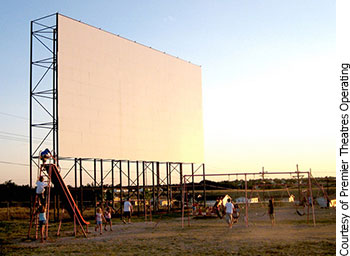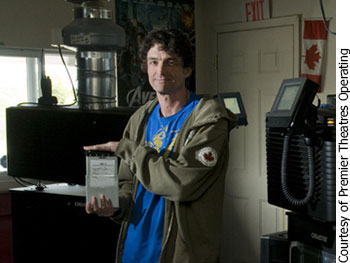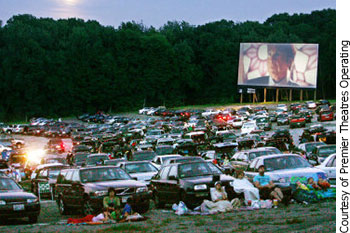Tags
Related Posts
Share This
Let’s all go to the drive-in
The lot at Oakville’s 5 Drive-In can hold 1,000 cars at full capacity. On discount nights during the summer (Tuesdays and Thursdays), the drive-in usually turns away a couple hundred cars. Often, the wait to enter is so long that the line of idling vehicles snakes by the massive parking lot of the Silvercity theatre a few blocks away.

Big screen, big difference. Many Canadian drive-ins offer screens that dwarf an IMAX screen, without the IMAX surcharge.
How can this summer moviegoing pastime keep up with the giant multiplex down the street? The answer: lower pricing – kids’ tickets are just $2 – and nostalgia. Brian Allen, whose Premier Theatres operates the 5 Drive-In as well as locations in Barrie, Hamilton and London, insists on playing a cheesy 1950s commercial with a dancing hot dog before the feature presentation. Otherwise, he says customers will complain.
“People love drive-ins,” Allen says. “The drive-in gives you the feelings of simplicity and serenity that audiences don’t get anymore. We offer something that is very unique and very vintage. The demand is still there.”
Several of Canada’s 56 drive-ins are still pulling in strong business, even as attendance at movie theatres declines across the country. Allen says that his chain of theatres had its biggest year ever last summer. The past year also saw the highest grosses in recent times for the Starlite Drive-In in Grand Bend, Ont., as well as the Port Elmsley Drive-In, located an hour south of Ottawa. Starlite owner Allan Barnes added a second screen last spring to ensure that hit movies could play beyond the two-week industry standard.
Low price, high standard
‘People love drive-ins. They give you the feelings of simplicity and serenity that audiences don’t get anymore.’ – drive-in owner Brian Allen
Allen’s business is just one instance of a drive-in reeling in big crowds during a time when Canadians are more likely than ever to wait and see blockbuster movies at home. Although North American movie theatres sold $10.2 billion worth of tickets in 2011, that figure is clouded by 3D and IMAX surcharges. In fact, 2011 was the least-attended year for movie theatres since 1995, according to revenue tracking website Box Office Mojo. Industry analysts predict that the steady rise in ticket prices and the success of cheaper home viewing options like Netflix have made attendance dip.
However, Canadian drive-ins located near urban markets have resurged in recent years, helped by discount pricing. While Silvercity charges close to $10 for a kid’s ticket per show, children age six to 12 can go to the 5 Drive-In for just a toonie and get a double feature.
Allen says that the films are not the only driving factor of his business. He says that the “personal sovereignty” that audiences get at a drive-in makes the experience worthwhile. “People come every week. Our following is so loyal,” Allen says. “There’s a real sense of community. There’s very few reasons for different groups to assemble anymore and the drive-in offers that. People have such an emotional connection to the [drive-in]. Who has an emotional connection to a Cineplex?”

Premier Theatres owner Brian Allen shows off a hard drive that carries a new release. Instead of needing a projectionist and several massive reels of film, Allen can plug this portable hard drive into a digital projector and let a film play unsupervised.
Although drive-ins are frequently thought of as an arcane pastime, there are still more than 400 sites operating throughout North America. When Statistics Canada last surveyed theatre attendance in 2006, attendance at national drive-ins had grown more than 20 per cent from 2003. These gains coincided with a 6.9 per cent drop in admission price and five new locations opening.
The latest drive-in to prosper in Canada is Stevie Rae’s South Western Drive-In. The theatre opened for business temporarily in Tilbury, Ont., last summer. Although the theatre was scheduled to halt construction only for a two-week preview in July, a town permit later extended this lease to two months, due to bigger-than-expected crowds on opening week.
Kelly Impens, who owns the drive-in with her husband, Steve, says that a lack of nearby family entertainment has helped the theatre thrive. There hasn’t been a drive-in near Windsor since 1989. “It’s been gone for so long that everybody appreciates it coming back,” she says. “There were a lot of people that grew up on the drive-in, and I think they started to go away because it was hard for [these theatres] to get the first-run movies, which is totally possible for the drive-ins now.”
Social media helped to spur demand for the new theatre. Stevie Rae’s had close to 5,000 Facebook fans before it opened its gates last July. The drive-in’s first screen accommodates 178 vehicles, while a second, smaller lot is set to open in the spring.
The demand for digital
Many of Canada’s 56 drive-ins still pull in strong business, even as attendance at movie theatres declines nationwide.
Some drive-ins are doing so well that their owners have already raised enough money to install digital projectors. This year, Hollywood studios will ship new releases only on hard drives that can be shown on these projectors. This way, distributors can save thousands of dollars normally spent on film reels by making a hard drive copy for about $60. Many Canadian drive-in owners have already upgraded; however, this shift will make it difficult for smaller, independent theatres to stay in business.
Starlite owner Allan Barnes says that digital technology is an annoyance. “It’s a technological change we didn’t need,” he says. “It’s not offering anything more to the customers in terms of quality presentation. The only reason it looks better is because it’s brand-new equipment.”
Allen, who spent $80,000 apiece on digital projectors for his drive-ins’ 11 screens, disagrees. He tested out the different formats by screening a reel of 35-millimetre film on one screen and a digital copy next to it. When he contrasted the picture side-by-side, Allen says he was surprised by the difference. “It was like an old floor wax commercial,” he says. “The 35mm looked yellow against the digital. The digital was white. The colours really popped.”

Field of dreams. Audiences embrace the outdoor setting and the low prices, and some drive-ins are thriving.
This upgrade can be an expensive fee – more so than for multiplexes. The cost for regular exhibitors to buy new digital systems is between $50,000 and $75,000 per screen, less than what Allen paid. Due to the outdoor location, the massive screen size and the longer distance from the booth to the screen, drive-in owners need projectors that are more powerful. While cheaper equipment is expected to hit the market for screens less than 30 feet wide, many drive-in screens are larger than that.
Even though many are still pulling in strong business, some of Canada’s 56 drive-ins are bound to close this year. The cost of moving to digital could drive nearly 20 per cent of all smaller theatres out of business. Meanwhile, Canada’s two largest film exhibitors – Cineplex Entertainment and Empire Theatres – have converted nearly all of their auditoriums to digital.
Regardless of these closures, Allen insists that the drive-in can still flourish as a spot for Canadians, since owners can cater to audiences in original and unusual ways. Among the features at the Premier drive-ins are a beach volleyball court and a playland area for kids. “There’s very few reasons for different groups to assemble anymore, and the drive-in offers that,” Allen says. “People can bring their babies; people can smoke; people bring their puppies. We have dog stops for all the dogs…You give them free kibble. We do all that kind of stuff that gives people a warm, fuzzy feeling. It’s a unique business. We let people experience the uniqueness in their own way.”





